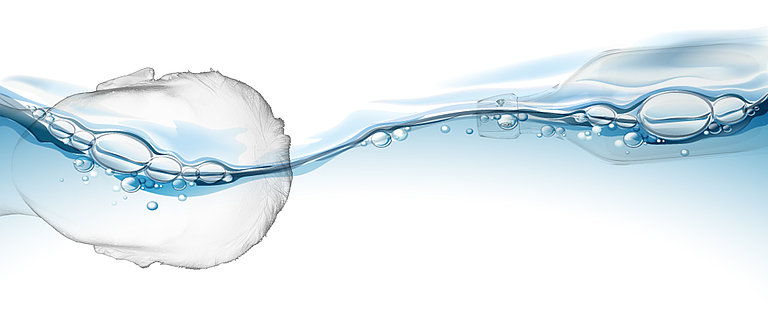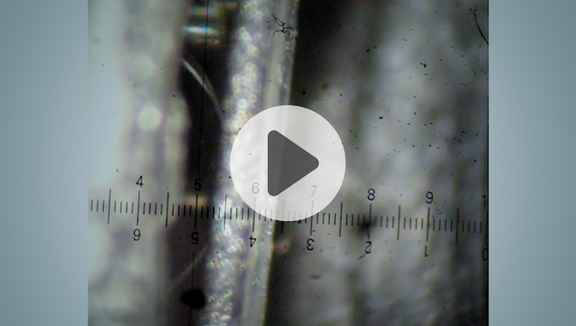Foundations of fluid mechanics,
or of beakers, bottles and people
Are fluids just fluids
When treating hydrocephalus it is impossible to avoid looking at the qualities and unique characteristics of fluids. Like all other fluids, CSF obeys very specific laws of physics. If you want to or have to drain this fluid it is worth understanding these rules.
show moreOf beakers, bottles and people
When treating hydrocephalus it is impossible to avoid looking at the qualities and unique characteristics of fluids when subjected to gravity. For a start, like all other fluids, CSF obeys very specific laws of physics. If you want to or have to drain this fluid is worth understanding these rules.
This eventually gets complicated, at least when it comes to an artificial channel between the cerebral cavities and the abdominal cavities – namely the implanted shunt system. Subject areas such as hydrostatics and hydrodynamics become relevant and can significantly affect the success of hydrocephalus treatment. What happens to pressure ratios in bottles, beakers and people when the position changes, when the bottle falls over, when the person lies down or when artificial outflows come into play? Why are bottles and beakers a popular model when it comes to demonstrating the so-called "siphon effect" and the consequences of overdrainage? This article should provide answers to these questions.

Hydrostatics in the shunt system
So, what do people, bottles and beakers have in common? At first glance, it might seem easier to describe how they are different. However, we will see that both of the latter can be used as substitutes for people, as (albeit very grossly) simplified examples, if they are looked at in a certain way. Bottles and beakers can be used to create simple models that can help us to understand basic hydrostatic effects within the human body.
![[Translate to English:] Hydrostatik im Shuntsystem [Translate to English:] Hydrostatik im Shuntsystem](https://www.miethke-journal.com/fileadmin/_processed_/c/b/csm_MJ_Kapitel1_f3da3837b2.jpg)
However, we should begin by defining what exactly we mean when we talk about beakers, bottles and people in terms of fluid mechanics.
Here, beakers represent open containers for water or other liquids where there IS direct contact between the fluid and the surrounding air. The pressure on the "exposed surface" of the liquid in the beaker is known, corresponding to the prevailing atmospheric pressure.
In this context a bottle is a rigid container for liquids that is closed on all sides, meaning there IS NOT any contact between the liquid and the surrounding air. The liquid pressure on the "open surface" of the liquid in the container is "frozen" and is no longer evident from outside.
People constitute a type of container, in both a philosophical and physical sense: containing thoughts, organs and all types of fluids. Air circulates in our lungs, blood circulates through our brains and CSF circulates through our cerebral cavity system.
FLUID
The term "fluid" refers to a substance, which, unlike a solid, does not offer any resistance against external forces, but rather allows itself to be continuously morphed by external forces.
If, when it is forced to change shape in this way, there is no change in volume (meaning the fluid cannot be compressed), then we can generally refer to it as a liquid, as is the case with water and even Liquor cerebrospinalis.
We will see, that in this context, a person is more similar to a closed bottle than a beaker that is open to the surrounding environment. However, more about that later. We will begin by focusing on the water in our cerebral cavity system - cerebrospinal fluid:
Cerebrospinal fluid (or CSF for short) is a clear liquid, similar to water, which is mainly composed of blood plasma, with only a small proportion of cellular components. These mainly consist of lymphocytes, but also include protein and albumin. This is produced through arterial circulation in the inner parts of the brain, mainly in the choroid plexus. According to current knowledge, it is resorbed again in the arachnoid granulations, as well as other places.

A person has between approximately 100-200 ml of CSF in their cerebral cavity system and spinal cavity at all times. A healthy person produces around 500 ml of this fluid daily, meaning that the CSF is completely replaced several times over the course of one day - the ventricles and spinal cavity are thoroughly rinsed out.
CSF has a wide range of functions, some of which are still currently being researched. One of its functions is to protect the human body's central nervous system from external shocks and pressure. Its cellular components allow it to carry out immunological functions, it helps detoxify the brain by absorbing and removing metabolic end products and it absorbs part of the brain's weight due to the effect of neutral buoyancy.
BUOYANCY
The term "buoyancy" refers to a fundamental phenomenon in fluid mechanics. According to this phenomenon, a body in a fluid is subjected to a force that acts against the force of gravity being exerted from outside. A ship floating in water or the human brain suspended in CSF are both examples of this. According to Archimedes' principle, the buoyant force produced by the weight is equal to the weight of the liquid displaced by the body. The weight of the water displaced by a ship in the sea "pushes" the ship "upwards".
The causes of buoyancy stem from the nature of liquids at rest in the gravitational field of the earth. To be more specific: the pressures the liquid is subject to. The scientific subfield dealing with the phenomena that arise from this is known as "hydrostatics".
In physical terms, pressure is defined, very generally, as "the weight exerted on a specific surface area". Pressure p is generated when a physical force F is exerted on the surface of a solid or fluid: in fluids the pressure is exerted evenly p = F/A as long as gravity is not taken into account. A good example of this is a balloon, in which the force F of the gas or water presses against the tension generated by the balloon's skin. In this case, there will be overpressure in the balloon relative to the surrounding atmosphere.
Overpressure (hydrocephalus) can also arise inside the skull, including as a result of the "masses" mentioned above, e.g. excess buildup of CSF, bleeds or a growing tumour. The necessary force is generated by their expansion or growth.
If we then take gravity into account, another special form of pressure will arise due to the weight of the fluid itself. This is known as "hydrostatic pressure". This phenomenon is known as the "basic hydrostatic law" and in physics, is referred to as the "basic hydrostatic equation". This law is essential for understanding why differences in pressure are generated in shunts regardless of the position the body is in. It is also important for understanding why, in the worst case scenario, ventricles can literally be sucked dry, as well how to prevent this from occurring.
To describe this in the simplest possible terms: Every liquid has a mass, and this is subject to a weight within the Earth's gravitational field. Therefore, the load on an imaginary body within the liquid, stemming from the "open surface" (i.e. the boundary between the liquid and the surrounding atmosphere, which is subject to a known amount of (air) pressure) increases in proportion to the depth of the liquid. However, the amount of liquid pressure this generates depends solely on the height of the column of liquid above. This is not affected by the shape of the vessel or the mass of the liquid that is above the area subject to observation.
A good example is a beaker (of any shape) filled with water: unlike in a balloon, the water does not have to be pushed down into the glass by a special force, it only has to be filled up. Naturally, the water's surface is always subject to the ambient pressure, i.e. the atmospheric pressure (which will be approximately 1 bar, depending on the weather). The bottom of the beaker is still subject to the same ambient pressure, but is also subject to the load consisting of the entire weight of the column of water (not the weight of the water in its entirety) above the bottom of the glass. The latter generates additional pressure. This is the hydrostatic pressure mentioned that was mentioned the start. It begins at "zero" on the water's surface, and gets closer to the maximum the deeper the point is under the water (relative to the surface). This is due to the fact that an increasing weight of water is exerting a load on the area in which pressure is being observed.
THE BASIC HYDROSTATIC EQUATION
For experts and those who want to learn more: Hydrostatic pressure can worked out very easily. To do this, all you need are a few simple physical formulae:
(1)Pressure = force/area;
p = F/A (general definition)
(2)Hydrostatic pressure = weight/area;
pHP = G/A (special definition)
(3)Weight = mass * constant; W = G * const.
(in which M is the mass of the body in g or kg, const./natural constant)
(4)Density = mass/volume; d = M/V
(Density of water: d = approx. 1 g/cm3/material constant)
Equation (4) can be used to calculate the mass of the water:
M = d * V (5).
The volume of the "water cylinder" in cases where there is a glass of water is calculated using the following image of V = h * A (6) in which A is the area of the base of the glass and h is the height of the water level in the glass: see the diagram on the right
When (6) is inserted into (5) it results in:
M = d * V = d* h* A (7)
Placing the hydrostatic pressure from (2) into (3) and (7) produces the following equation:
pHP= G/A = M*const./A = d*h*A const./A (8).
By simplifying this we finally come to the basic hydrostatic equation:
pHP = D * const.*h (9).
It is therefore clear that hydrostatic pressure is solely and exclusively dependent on the height of the column of liquid (h) (except for the density of the liquid (d)).


The hydrostatic paradox
At first glance, this situation seems counterintuitive. Because of this, we also refer to the so-called hydrostatic paradox in this context.

Our everyday experience teaches us all that whether we dive down 10 metres into a swimming pool or 10 metres into the ocean, makes no difference to the pressure we feel in our ears.
Therefore, depth is the only thing that matters in terms of hydrostatic pressure.
Hydrostatic pressure in cmH2O
To use technical jargon, pressure in the CFS is measured using the non-SI unit "cmH2O" ("SI" stands for Système international d'unités or the "International System of Units"). This unit is otherwise known as the "centimetre of water". This is a type of so-called "differential pressure", which is used to describe the difference in pressure between the cranial cavity and the external air pressure.
cmH2O is defined as the hydrostatic pressure exerted by a one-centimeter-high column of water, in which the density of the water is precisely one gram per cubic centimetre. It is expressed differently to the unit "Pa", which is normally used to measure pressure. Unlike a "Pascal", which is defined as the force of one Newton applied to an area of one cubic metre, the cmH2O is a unit that does not have to refer to an effective surface area. It only refers to a one-dimensional measure of length, namely the height of the column of water exerting force on the relevant pressure point. This goes against our intuitive understanding of pressure, however, in doing so, it makes the effect of hydrostatic pressure (i.e. the pressure in a medium, such as a liquid, that is generated by the weight of the medium itself) clearer. In other words: the pressure is generated because the medium is pressing against itself with its own weight.
One cmH2O corresponds roughly to one millibar, or, in SI units: 1,000 Pascal.
Hydrostatic pressure can be calculated using the following formula:
HSP = rho * g * h
In this formula h (the height of the column of water), rho and g are physical constants.
In the past, mercury, which is much heavier than water, was also commonly used in columns of liquid. 1 mm of mercury (1 mmHg, also known as torr) generates roughly the same pressure as 1.36 cm of water. The old unit "torr" is still frequently used today, especially in medicine.

The pressure distribution in the CSF contained in the cerebral cavity system and spinal cavity of the human body is no different to that of a beaker filled with water. However, there is one crucial difference between the two: there no "open surface" with a known level of atmospheric pressure in the human body.
Because of this, upon closer observation, the column of CSF in the spinal cavity in fact resembles an upright bottle in the Earth's gravitational field, in which the absolute pressure ratios cannot be determined from the outside. However, we can draw conclusions about the pressure gradient in CSF by making analogies with simple hydrostatic systems: the pressure steadily increases from the top to the bottom in proportion to the height of the column of CSF. Even this model is not entirely accurate, after all, the human body is not rigid. However, to begin with, this is a high enough level of detail for the purpose of examining the hydrostatic phenomena set out here.
The following example will demonstrate how pressure ratios in real hydrostatic systems (similar to those the human body or in a shunt, for example) can quickly become complex and confusing, despite the simplicity of the basic law (the basic hydrostatic equation):
In the diagram below there are eight pipes labelled A-H, which are very similar at first glance. However, despite their similarity, they are subject to fundamentally different hydrostatic, and in some cases, hydrodynamic forces (where the water is moving):

A A liquid with px of overpressure was squeezed into the rigid pipe "A". The system was then tightly sealed immediately afterwards. In the rigid pipes, the overpressure is being maintained. If the pipes had been flexible, they would blow up like a balloon due to the px of overpressure. When it is placed in an upright position, the bottom of the pipe is subject to overpressure of px plus the hydrostatic pressure (HP)+ 10 cm.
B Pipe B has an opening, through which it is exposed to the outside air. As a result, there is no longer an overpressure of px. Therefore, by definition, it is 0 at the top and at +10 cmH2O at the base below.
C Pipe C is open at the bottom and sealed at the top. By definition, the bottom is subject to 0 cmH2O. The water cannot flow away, as this would create a vacuum above, as has previously been mentioned. However, it will attempt to flow away: the hanging column of water pulls the cap at the top down, generating a negative hydrostatic pressure of -10 cmH2O, which is also known as suction force.
D Pipe D is identical to C, but in this case the cap is slightly flexible, therefore clearly demonstrating the real existence and effect of the suction. This is important, as "nothing", in the fullest sense of the word, can be seen. There is "no flow" to be seen either, meaning that the existence of suction is a mere assertion.
E Pipe E is open at the top and bottom and therefore just empties out. The driving force behind this process is simply the water, which is able to "fall" down unimpeded.
F In pipe F the hole out to the external air, at which point there is a differential pressure of 0 cmH2O, is right in the middle. Nothing can flow away, but the hydrostatic pressure at the bottom is now only +5 cmH2O and the suction at the top is only -5 cmH2O, due to the lower hydrostatic level.
G In pipe G there is also a flexible cap, to show the real existence and effect of the suction. If the lower cap was also flexible it would bulge outwards due to the positive overpressure.
H In pipe H there is no upper cap, meaning that the liquid flows away, leaving it half-full. Only a positive hydrostatic pressure of + 5 cmH2O remains at the base.
This section will very specifically look at pipes (C) and (D), which illustrate how the so-called "siphon effect" occurs. This is very important in relation to shunt therapy. As long as the patient is standing up, the catheter full of liquid, which runs from the ventricles (the closed end) to the abdomen (the peritoneum, at the open end), actually constitutes the same type of system. The high level of suction that this produces in the ventricles is physically unavoidable and special implants are required to counteract it.
In essence, this effect is also responsible for the fact that cerebral pressure of a healthy person who is standing up is slightly negative. When in this position, the CSF therefore sinks out of the ventricles down into the dural sac (in the vertebrae). Although the dural sac is not open at the bottom like in pipes C and D, it is quite flexible and is capable of taking in some extra CSF. Luckily, there are also a few other physiological mechanisms to ensure that "physiological" (healthy) cerebral pressure does not drop to -100 cmH2O when a person stands up, instead only dropping to around -5 to -15 cmH2O.
If one of the pipes were to fall over (or if a person lies down) the height of the column of water would suddenly increase. The difference in pressure between two different places (such as the neck and base of the bottle) will become level within the Earth's gravitational field as soon as they are at the same hydrostatic level.
To summarise: When using a very rough model, we can treat a person as an upright bottle in the Earth's gravitational field, filled with CSF. When this bottle is in an upright position, the liquid pressure of the CSF in the head will be lower than that in the spinal cavity. When the bottle has been closed we cannot determine what the pressure is simply by looking at it.
It is therefore possible to infer what is happening to the pressure of the CSF in the human body when it is leaning over, bending or lying down on the basis of these simple physical thought experiments based on beakers and bottles. The hydrostatic pressure of the CSF in different parts of the human body is not constant, instead "adapting" to the position it is in and the activity it is doing.

Making the assumption that the pressure ratios in the human body can be described using hydrostatics alone allows us to reach a basic understanding of these phenomena. This alone is sufficient to allow us to observe and measure them. This can be very important when treating hydrocephalus, e.g. when avoiding overdrainage.
However, it still constitutes a gross simplification of the actual, highly complex conditions within the human body. Finally, the CSF in the brain is produced by the blood and resorbed by it. As a result, there are sources and sinks, and therefore, flow, even if it is slow. The CSF circulates around the cerebral ventricular system as a result of the pulsing of the arteries within the cerebral ventricle and, according to the latest research, due to the significant effect of the movements the body makes when breathing. Modern flow-sensitive real-time MRI scans of the human skull actually provide convincing proof that this circulation takes place (Dreha-Kulaczewski1, 2017).
Hydrodynamics in the shunt
The flow manifests itself if cerebral ventricular system is "disturbed" by a shunt: the difference in pressure between the ventricles and the peritoneum allows for a "net flow" of CSF into the peritoneum through the artificial channel, which is regulated by a special differential pressure or hydrostatic valve. According to the continuity equation, when liquid is being continuously produced, it flows more quickly the narrower the channel is. Because of this, the liquid will flow more quickly through a relatively narrow catheter than, for example, a reservoir with a significantly larger flow cross-section. If, for example, 20 ml of CSF is drained per hour, it will flow through the catheter at a constant rate of 5 millimetres per second. However, the speed of the liquid increases in direct proportion to the cross section width what it is flowing through.
The continuity equation
The continuity equation is one of the basic equations of hydrodynamics and can be interpreted as a simple mass equation at a control volume. To put it more simply: “What goes in must come out”. This can be worked out in quite a clear way and with only a little basic knowledge of physics and mathematics by using the following axioms:
- (Mass/time)_in = (mass/time)_out
- Mass=density*volume / / Assumption: the density is constant.
1. means that in 2: (Volume/time)_in = (volume/time)_out
<-> ((Time) * (distance/time))_in = ((area) * (distance/time)_out / / Speed = distance/time with volume = area * distance
Therefore:
V_in*A_in = V_out*A_out

Some may know it from canoeing through narrow canals: The narrower the canal, the faster the canoe floats with the current.
Some of you might already be familiar with this effect from canoeing down narrow channels: the narrower the channel is, the faster the canoe floats along with the current.
If then the flow rate through a hydrocephalus valve with a potentially enlarged cross section is slowed down, the tissue particles, proteins and sometimes also blood may interact with and adhere to the interior surfaces of the valve due to long periods of exposure (due, in part to turbulence and bottlenecks at places with an irregular geometry, where the CSF is almost still). This can gradually lead to valve occlusion.
"... found in relation to toxicity and oncogenity. Minor problems existed in relation to CSF proteins and medium difficulties in relation to corpuscles (blood). Surprisingly with 500 mg/dl protein, most valves showed – in short term – no significant alteration except of some sticking proximal slit probes and sometimes Orbis-Sigma valves. The trials of Brydon et al. (1996) could be confirmed. Protein effects are usually overestimated. Corpuscles and blood are more by far at risk for valve occlusions (Aschoff 1995)."
Aschoff2, 2019
Understanding of the exact mechanisms of valve occlusions.at a molecular level is important for the long-term success of a shunt, and is therefore currently the subject of scientific research. We still do not know very much at all about the reasons why blockages occur. However, we suspect that taking flow speed into account is probably of greater importance when designing shunt systems.
Noises in the valves
The flow rate through the pump can also be important for reasons other than occlusions. The occurrence of valve noises (which have been reported by some hydrocephalus patients) can also be explained by phenomena related to the flow rate of the CSF.
This can be illustrated with a simple differential pressure valve. For example, with a ball-cone valve, the pressure proximal to the shunt builds up until it can overcome the force of the spring element in the valve. When the force generated by the pressure finally exceeds the spring force, the ball moves, opening the liquid channel, which means the fluid can move.
Specific conditions may cause the valve to close right after opening, due to a sudden pressure drop in the CSF. One of the reasons for this pressure drop is the reduction in pressure on the side subject to overpressure, due to the liquid being drained away. This can take place very quickly, depending on the specific anatomy of the person (e.g. cerebral compliance, split ventricles etc.). There is also another type of pressure drop, which can be explained by what is known as "Bernoulli's equation". This states that the pressure in a moving fluid is lower than that in a fluid that is still. What this actually means for the valve is that the faster CSF moves through the open valve, the bigger the pressure drop that follows and, in turn, the greater the likelihood of the valve closing quickly again will be.
Bernoulli's equation
For those with an interest in fluid mechanics, Bernoulli's equation is something that often provides an initial insight into the conditions within otherwise complex hydraulic systems. Ultimately, it is a variation of the principle of conservation of energy, which states that the sum of potential energy density (the hydrostatic column of water), kinetic energy density and the energy of the forces within the fluid (static pressure) always remains constant along a streamline:
Special definition Potential energy + special definition Kinetic energy + special definition Internal energy = const.
rho g h + ½ rho v² + p = const.
Strictly speaking, this only applies to homogenous flows. These are idealised, i.e. hypothetical flows that are stationary (no local variations in velocity), incompressible and free of pressure loss. There are, however, formulations of Bernoulli's equation that take pressure loss caused by turbulence or pipe friction into account by adding another term.
An outcome of this equation is that the internal or "static" pressure of a liquid becomes lower the more quickly the fluid moves. This is often clearly demonstrated by using the example of the so-called Venturi tube, which is shown in the following diagram:

Although the flow velocity is highest at the narrowest cross section (cf. the continuity equation), this is also where the internal pressure of the flow is at its lowest, causing the column of liquid in the U-tube manometer in the diagram to shift in the way depicted.
To allow the pressure to immediately start building up again, it is therefore necessary to repeatedly open and close the valve, which also creates audible noises.

This phenomenon can also be proved experimentally, as can be see in the following video:
We can therefore see the following: Although fundamental phenomena of cerebrospinal pressure and hydrocephalus therapy can be described using simple hydrostatic models, you cannot avoid also using hydrodynamic models when seeking to understand fluid mechanics and their effects within the shunt.
This does not come close to answering all the questions there are regarding hydrostatics and hydrodynamics in shunt systems. I look forward to receiving suggestions or questions that we can address in greater detail in other articles.
Finally, and to further emphasise this complexity, the "simple" physical answer to a question we are often asked. That is, why the opening pressures of a series of closed valves have to be added up:
1 + 1 = 1? Or Adding up the opening pressures of a series of closed valves
The balanced equations of fluid mechanics can also help to explain a popular misconception in relation to the combination of hydrocephalus valves and, in particular the series connection of valves with different opening pressures. Are the individual opening pressures really added up? Doesn't the higher opening pressure control the flow of CSF through the shunt, as the more dominant one of the two?
By having regard to hydrodynamic balancing equations and a bit of faith in theoretical physics, this question can be answered without having to conduct any experiments. This only requires a simple momentum balance, or, in a borderline hydrostatic case, a power balance as well, with the control volume being provided by "the column of CSF in the shunt". Taking into account the fact that the column of liquid being observed constitutes a so-called continuum and every mass within the liquid creates pressure on the border of the control volume makes it clear that the individual masses are not entered into the balance equation separately, rather, they are inserted into it after having been added up.
Or to explain things in more detail, as well as in simpler and less abstract terms:
Let us imagine a series of two simple ball-cone valves with two different (blue) springs, one behind the other.

The blue springs have different spring constants - one has a low spring constant (SC1) and the other has a high spring constant (SC2). The liquid medium in between is incompressible and can therefore (thankfully) be replaced, e.g. by a steel rod (depicted in green), which connects them both to each other and therefore transfers the force directly. It now becomes clear that the entire system can only be opened when the steel rod is pressed down with a force that counteracts the sum of BOTH SPRING CONSTANTS, SC1 + SC2, which is what is meant by a balance of forces.
Bibliography
Dreha-Kulaczewski 2017: Inspiration is the major regulator of human CSF flow
Aschoff 2019: in In-Depth View — Functional Characteristics of CSF Shunt Devices (Pros and Cons)
Kästner 2017: I can hear my shunt — audible noises associated with CSF shunts in hydrocephalic patients
